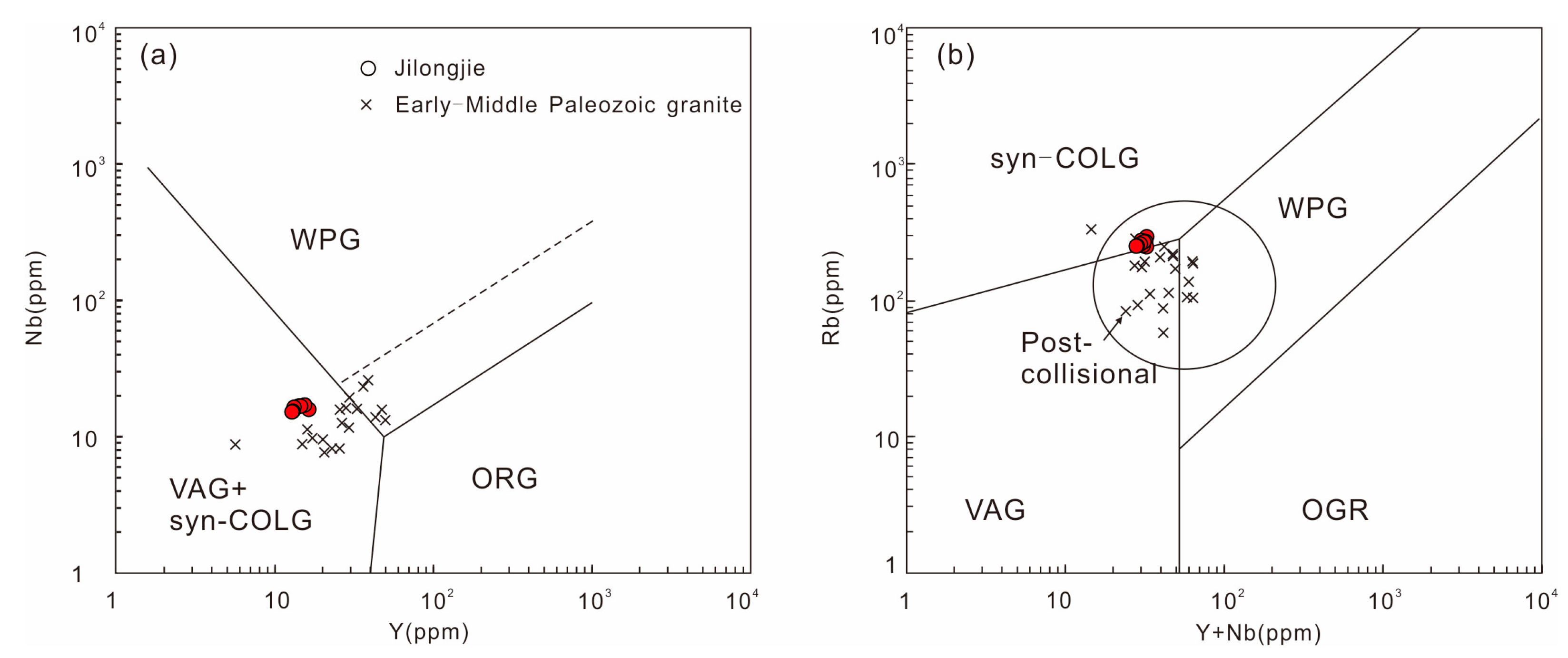Geochronology and Petrogenesis of the Early Paleozoic Jilongjie Granites in the Central South China Block: Implication for Post-Kinematic Lithospheric Delamination
Abstract
1. Introduction
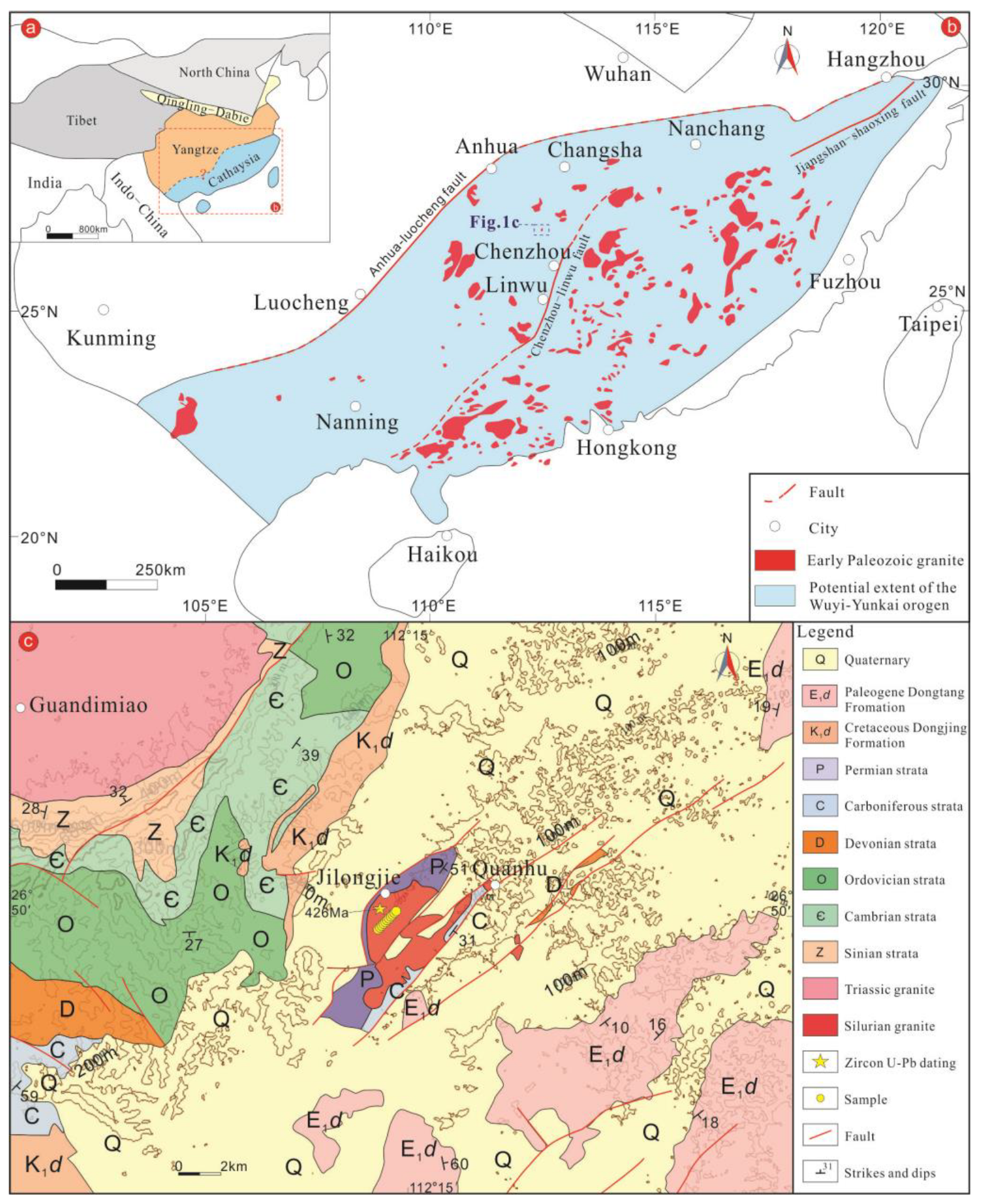
| Number | Locality | Lithology | Dating Method | Age (Ma) | Literature |
|---|---|---|---|---|---|
| 1 | Tanghu | Granite | Zircon U-Pb dating | 433 ± 2 | [28] |
| 2 | Wangyangshan | Granite | Zircon U-Pb dating | 434 | [29] |
| Guidong | Granodiorite | Zircon U-Pb dating | 425.5 ± 1.7 | ||
| Zhaiqian | Granite | Zircon U-Pb dating | 430.7 ± 1.9 | ||
| 3 | Napeng | Granite | Zircon U-Pb dating | 418 ± 12 | [30] |
| 4 | Song Chay | Granite | Zircon U-Pb dating | 428 ± 5 | [31] |
| 5 | Zhuguang | Granite | Zircon U-Pb dating | 446.7 ± 6.3; 424.6 ± 3.7 | [32] |
| 6 | Songwang | Foliated granite | Zircon U-Pb dating | 440.7 ± 5.6 | [7] |
| Dagu | Granitic gneiss | 421.9 ± 9.8 | |||
| Yuntan | Biotite orthogneiss | 427.1 ± 4.2 | |||
| Chidong | Biotite paragneiss | 423.0 ± 7.0 | |||
| Hebapu | Granitic gneiss | 429.6 ± 5.2 | |||
| 7 | Weipu | Granite | Zircon U-Pb dating | 427.4 ± 4.0 | [33] |
| 8 | Northwestern Fujian | Granite | Zircon U-Pb dating | 437 ± 5; 437 ± 4; 440 ± 5; 441 ± 4 | [34] |
| 9 | Tianjingping | Granodiorite | Zircon U-Pb dating | 447 ± 2 | [35] |
| 10 | Sibao | Granite | Shrimp U-Pb zircon | 432 | [26] |
| Weipu | 433 | ||||
| 11 | Yunkai | Granite; gneissic granite | Zircon U-Pb dating | 430 ± 10; 443 ± 4; 437 ± 5 | [36] |
| 12 | Wugong domain | Gneissoid granite; orthogneiss; migmatite | Zircon U-Pb dating | 455 ± 8; 455 ± 9; 456 ± 5; 443 ± 5; 424 ± 6; 452 ± 4 | [37] |
| Northern Wuyi domain | Genissoid granite; orthogneiss; migmatite | 410 ± 10; 427 ± 15; 430 ± 9; 457 ± 6 | |||
| Southern Wuyi domain | Genissoid granite; orthogneiss | 430 ± 6; 438 ± 3; 432 ± 6; 427 ± 4; 426 ± 6; 426 ± 8; 437 ± 3; 430 ± 6 | |||
| Yunkai domain | Orthogneiss; gneissoid granite; leucosome in migmatite; paragneiss | 450 ± 8; 449 ± 5; 443 ± 7; 415 ± 7; 435 ± 8; 452 ± 6 | |||
| 13 | Wuping | Gneissic granite | Zircon U-Pb dating | 496 ± 4; 494 ± 6 | [38] |
| 14 | Le’an | Biotite monzogranite | 429 ± 2 | [39] | |
| Zhangjiafang | Biotite monzogranite | 440 ± 2 | |||
| Shuangzhuang | Monzogranite; biotite monzogranite | 424 ± 4; 441 ± 3 | |||
| Pengongmiao | Monzogranite | 405 ± 3 | |||
| Wanyangshan | Monzogranite | 433 ± 4 | |||
| Tanghu | Monzogranite | 454 ± 2 | |||
| Banshanpu | Monzogranite | 418 ± 2 | |||
| Hongxiaqiao | Granodiorite | 432 ± 6 | |||
| Miaoershan | Monzogranite | 400 ± 4; 415 ± 2 | |||
| Haiyangshan | Biotite monzogranite | 429 ± 11 | |||
| Fengdingshan | Granodiorite | 402 ± 2 | |||
| 15 | Xuefengshan Beltt | Granite | Zircon U-Pb dating | 428 ± 4; 438 ± 3; 437 ± 4; 411 ± 4; 412 ± 4; 424 ± 3 | [40] |
| 16 | Taishan | Granite | Zircon U-Pb dating | 436 ± 3; 436 ± 3; 436 ± 4; 436 ± 6; | [41] |
| 17 | Yuechenling | Granite | Zircon U-Pb dating | 435 ± 4; 427 ± 3; 417 ± 6 | [27] |
| Miaoershan | 404 ± 4 | ||||
| 18 | Northern Guangdong | Basalt; andesite; dacite, ignimbrite | Zircon U-Pb dating; Shrimp U-Pb dating | 435 ± 6; 435 ± 6 | [42] |
| 19 | Yunkai | Charnockite | Zircon U-Pb dating | 439 ± 2; 439 ± 4 | [43] |
| 20 | Doulong | Granite | Zircon U-Pb dating | 429 ± 3; 430 ± 3; 430 ± 2; 430 ± 2 | [44] |
| 21 | Shangmushui | Granodiorite | Zircon U-Pb dating | 444 ± 4 | [45] |
| 22 | Wanyangshan | Tonalite; granodiorite; monzonitic granite | Zircon U-Pb dating | 438 ± 3; 426 ± 3 | [46] |
| 23 | Daning | Granite | SHRIMP | 419.1 ± 6.4 | [47] |
2. Geological Setting and Petrography
3. Analytical Methods
4. Results
4.1. Zircon U-Pb Geochronological Results
4.2. Whole-Rock Geochemistry
4.3. Zircon Hf Isotopic Results
5. Discussion
5.1. Genetic Type and Magma Source
5.2. Magma Source
5.3. Tectonic Implications
6. Conclusions
- (1)
- The Jilongjie pluton was emplaced at ~426 Ma and displays shoshonite and metaluminous characteristics.
- (2)
- Jilongjie granites’ parent magma originated from a mixing of crust-derived felsic and mantle-derived mafic magmas, and then underwent fractional crystallization during its ascent and/or emplacement.
- (3)
- The post-collisional extensional mechanism associated with the delamination of the thickened lithosphere was responsible for post-435 Ma igneous rock (including the Jilongjie pluton) in the SCB.
Author Contributions
Funding
Data Availability Statement
Acknowledgments
Conflicts of Interest
References
- Li, X.H.; Li, Z.X.; Zhou, H.W.; Liu, Y.; Kinny, P.D. U–Pb zircon geochronology, geochemistry and Nd isotopic study of Neoproterozoic bimodal volcanic rocks in the Kangdian Rift of South China: Implications for the initial rifting of Rodinia. Precambrian Res. 2002, 113, 135–154. [Google Scholar] [CrossRef]
- Li, Z.X.; Li, X.H.; Li, W.X.; Ding, S.J. Was Cathaysia part of Proterozoic Laurentia?–New data from Hainan Island, south China. Terra. Nova 2008, 20, 154–164. [Google Scholar] [CrossRef]
- Li, Z.X.; Zhang, L.H.; Powell, C.M. South China in Rodinia: Part of the missing link between Australia–East Antarctica and Laurentia? Geology 2015, 23, 407–410. [Google Scholar] [CrossRef]
- Zhou, X.M.; Zhu, Y.H. Late Proterozoic colisional orogen and geosuture in Southeastern China- Petrological evidence. Chin. J. Geochem. 1993, 12, 239–251. [Google Scholar]
- Charvet, J.; Shu, L.; Shi, Y.S.; Guo, L.Z.; Faure, M. The building of south China: Collision of Yangzi and Cathaysia blocks, problems and tentative answers. J. Southeast Asian Earth Sci. 1996, 13, 223–235. [Google Scholar] [CrossRef]
- Sun, T. A new map showing the distribution of granites in South China and its explanatory notes. Geol. Bull. China 2006, 25, 332–335. [Google Scholar]
- Wang, Y.; Fan, W.; Zhao, G.; Ji, S.; Peng, T. Zircon U–Pb geochronology of gneissic rocks in the Yunkai massif and its implications on the Caledonian event in the South China Block. Gondwana Res. 2007, 12, 404–416. [Google Scholar] [CrossRef]
- Ren, J.S. On the Geotectonics of Southern China. Acta Geol. Sin. 1991, 4, 111–130. [Google Scholar]
- Li, Z.X.; Li, X.H. Formation of the 1300-km-wide intracontinental orogen and postorogenic magmatic province in Mesozoic South China: A flat-slab subduction model. Geology 2007, 35, 179. [Google Scholar] [CrossRef]
- Shu, L.S. Predevonian Tectonic Evolution of South China:from Cathaysian Block to Caledonian Period FoldedOrogenic Belt. Geol. J. China Univ. 2006, 12, 418–431. [Google Scholar]
- Chen, X.; Zhang, Y.; Fan, J.; Cheng, J.; Li, Q. Ordovician graptolite-bearing strata in southern Jiangxi with a special reference to the Kwangsian Orogeny. Sci. China Earth Sci. 2011, 53, 1602–1610. [Google Scholar] [CrossRef]
- Shu, L.; Faure, M.; Wang, B.; Zhou, X.; Song, B. Late Palaeozoic–Early Mesozoic geological features of South China: Response to the Indosinian collision events in Southeast Asia. Comptes Rendus Geosci. 2008, 340, 151–165. [Google Scholar] [CrossRef]
- Shu, L.S.; Deng, P.; Yu, J.H.; Wang, Y.B.; Jiang, S.Y. The age and tectonic environment of the rhyolitic rocks on the western side of Wuyi Mountain, South China. Sci. China Ser. D Earth Sci. 2008, 51, 1053–1063. [Google Scholar] [CrossRef]
- Shu, L.S.; Yu, J.H.; Jia, D.; Wang, B.; Shen, W.Z.; Zhang, Y.Q. Early Paleozoic orogenic belt in the eastern segment of South China. Geol. Bull. China 2008, 27, 1581–1593. [Google Scholar]
- Wang, Y.; Fan, W.; Guo, F.; Peng, T.; Li, C. Geochemistry of Mesozoic Mafic Rocks Adjacent to the Chenzhou-Linwu fault, South China: Implications for the Lithospheric Boundary between the Yangtze and Cathaysia Blocks. Int. Geol. Rev. 2003, 45, 263–286. [Google Scholar] [CrossRef]
- Wang, Y.; Fan, W.; Sun, M.; Liang, X.; Zhang, Y.; Peng, T. Geochronological, geochemical and geothermal constraints on petrogenesis of the Indosinian peraluminous granites in the South China Block: A case study in the Hunan Province. Lithos 2007, 96, 475–502. [Google Scholar] [CrossRef]
- Wang, Y.; Zhang, Y.; Fan, W.; Peng, T. Structural signatures and 40Ar/39Ar geochronology of the Indosinian Xuefengshan tectonic belt, South China Block. J. Struct. Geol. 2005, 27, 985–998. [Google Scholar] [CrossRef]
- Wang, Y.J.; Zhang, Y.; Fang, W.M.; Xi, X.W.; Guo, F.; Li, G. Numerical modeling for generation of Indo–Sinian peraluminous granitoids Hunan Province: Basaltic underplating vs tectonic thickening. Sci. China (Ser. D) 2002, 45, 1042–1056. [Google Scholar] [CrossRef]
- Bao, H.Z.; Zhang, Z.C. Genesis of Silicic Large Igneous Provinces and effects of resources and environment. Acta Petrol. Sin. 2020, 36, 1973–1985. [Google Scholar] [CrossRef]
- Chen, A. Mirror-image thrusting in the South China Orogenic Belt: Tectonic evidence from western Fujian, southeastern China. Tectonophysics 1999, 305, 497–519. [Google Scholar] [CrossRef]
- Mao, J.W.; Xie, Z.Q.; Guo, C.L.; Yuan, C.D.; Cheng, Y.B.; Chen, Y.C. Spatial-Temporal distribution of Mesozoic ore deposits in South China and their metallogenic settings. Geol. J. China Univ. 2008, 14, 510–526. [Google Scholar] [CrossRef]
- Zhang, Q.; Jin, W.J.; Li, C.D.; Wang, Y.L. Yanshanian large-scale magmatism and lithosphere thinning in Eastern China: Relation to large igneous province. Earth Sci. Front. 2009, 16, 21–51. [Google Scholar]
- Wan, Y.; Liu, D.; Xu, M.; Zhuang, J.; Song, B.; Shi, Y.; Du, L. SHRIMP U–Pb zircon geochronology and geochemistry of metavolcanic and metasedimentary rocks in Northwestern Fujian, Cathaysia block, China: Tectonic implications and the need to redefine lithostratigraphic units. Gondwana Res. 2007, 12, 166–183. [Google Scholar] [CrossRef]
- Shen, W.Z.; Ling, H.F.; Li, W.X.; Wang, D.Z.; Huang, X.; Pan, J. The Nd-Sr isotope study of Mesozoic granitoids in Jiangxi Province. Chin. Sci. Bull. 1998, 43, 2653–2657. [Google Scholar] [CrossRef]
- Chen, J.F.; Jahn, B.M. Crustal evolution of southeastern China: Nd and Sr isotopic evidence. Tectonophysics 1998, 284, 101–133. [Google Scholar] [CrossRef]
- Li, Z.X.; Li, X.H.; Wartho, J.A.; Clark, C.; Li, W.X.; Zhang, C.L.; Bao, C. Magmatic and metamorphic events during the early Paleozoic Wuyi-Yunkai orogeny, southeastern South China: New age constraints and pressure-temperature conditions. Geol. Soc. Am. Bull. 2009, 122, 772–793. [Google Scholar] [CrossRef]
- Zhao, K.-D.; Jiang, S.-Y.; Sun, T.; Chen, W.-F.; Ling, H.-F.; Chen, P.-R. Zircon U–Pb dating, trace element and Sr–Nd–Hf isotope geochemistry of Paleozoic granites in the Miao’ershan–Yuechengling batholith, South China: Implication for petrogenesis and tectonic–magmatic evolution. J. Asian Earth Sci. 2013, 74, 244–264. [Google Scholar] [CrossRef]
- Li, X.; Tatsumoto, M.; Premo, W.R. Age and origin of the Tanghu Granite, south. Geology 1989, 17, 395–399. [Google Scholar]
- Li, X.H. Geochronology of the Wanyangshan–Zhuguangshan granitoid batholith: Implication for the crust development. Sci. China Ser. B 1991, 34, 620–629. [Google Scholar]
- Wang, J.H.; Sun, D.Z.; Chang, X.Y.; Deng, S.X.; Zhang, H.; Zhou, H.W. U–Pb dating of the Napeng granite at the NW margin of the Yunkai block, Guangdong, South China. Acta Mineral. Sin. 1998, 18, 130–133. [Google Scholar]
- Roger, F.; Leloup, P.H.; Jolivet, M.; Lacassin, R.; Trinh, P.T.; Brunel, M.; Seward, D. Long and complex thermal history of the Song Chay metamorphic dome (Northern Vietnam) by multi-system geochronology. Tectonophysics 2000, 321, 449–466. [Google Scholar] [CrossRef]
- Xu, X.; O’Reilly, S.Y.; Griffin, W.L.; Deng, P.; Pearson, N.J. Relict Proterozoic basement in the Nanling Mountains (SE China) and its tectonothermal overprinting. Tectonics 2005, 24, 1–16. [Google Scholar] [CrossRef]
- Chen, C.H.; Lee, C.Y.; Hsieh, P.S.; Zeng, W.; Zhou, H.W. Approaching the age problem for some metamorphosed Precambrian basement rocks and Phanerozoic granitic bodies in the Wuyi area: The application of EMP monazite age dating. Geol. J. China Univ. 2008, 14, 1–15. [Google Scholar] [CrossRef]
- Liu, R.; Zhang, L.; Zhou, H.W.; Zhong, Z.Q.; Zeng, W.; Xiang, H.; Ji, S.; Lv, X.Q.; Li, C.Z. Petrogenesis of the Caledonian migmatites and related granites in northwestern Fujian Province, South China: Syndeformational crustal anatexis. Acta Petrol. Sin. 2008, 24, 1205–1222. [Google Scholar]
- Zeng, W.; Zhang, L.; Zhou, H.; Zhong, Z.; Xiang, H.; Liu, R.; Jin, S.; Lü, X.; Li, C. Caledonian reworking of Paleoproterozoic basement in the Cathaysia Block: Constraints from zircon U-Pb dating, Hf isotopes and trace elements. Sci. Bull. 2008, 53, 895–904. [Google Scholar] [CrossRef]
- Wan, Y.; Liu, D.; Wilde, S.A.; Cao, J.; Chen, B.; Dong, C.; Song, B.; Du, L. Evolution of the Yunkai Terrane, South China: Evidence from SHRIMP zircon U–Pb dating, geochemistry and Nd isotope. J. Asian Earth Sci. 2010, 37, 140–153. [Google Scholar] [CrossRef]
- Wang, Y.; Zhang, A.; Fan, W.; Zhao, G.; Zhang, G.; Zhang, Y.; Zhang, F.; Li, S. Kwangsian crustal anatexis within the eastern South China Block: Geochemical, zircon U–Pb geochronological and Hf isotopic fingerprints from the gneissoid granites of Wugong and Wuyi–Yunkai Domains. Lithos 2011, 127, 239–260. [Google Scholar] [CrossRef]
- Zhang, A.; Wang, Y.J.; Fan, W.M.; Zhang, F.F.; Zhang, Y.Z. LA-ICPMS zircons U–Pb geochronology and Hf isotopic composition of the Taoxi migmatite (Wuping): Constrains on the formation age of the Taoxi complex and the Yu’nan event. Geotecton. Et Metallog. 2011, 35, 64–72. [Google Scholar]
- Zhang, F.; Wang, Y.; Zhang, A.; Fan, W.; Zhang, Y.; Zi, J. Geochronological and geochemical constraints on the petrogenesis of Middle Paleozoic (Kwangsian) massive granites in the eastern South China Block. Lithos 2012, 150, 188–208. [Google Scholar] [CrossRef]
- Chu, Y.; Lin, W.; Faure, M.; Wang, Q.; Ji, W. Phanerozoic tectonothermal events of the Xuefengshan Belt, central South China: Implications from UPb age and LuHf determinations of granites. Lithos 2012, 150, 243–255. [Google Scholar] [CrossRef]
- Huang, X.-L.; Yu, Y.; Li, J.; Tong, L.-X.; Chen, L.-L. Geochronology and petrogenesis of the early Paleozoic I-type granite in the Taishan area, South China: Middle-lower crustal melting during orogenic collapse. Lithos 2013, 177, 268–284. [Google Scholar] [CrossRef]
- Yao, W.-H.; Li, Z.-X.; Li, W.-X.; Wang, X.-C.; Li, X.-H.; Yang, J.-H. Post-kinematic lithospheric delamination of the Wuyi–Yunkai orogen in South China: Evidence from ca. 435Ma high-Mg basalts. Lithos 2012, 154, 115–129. [Google Scholar] [CrossRef]
- Wang, D.; Zheng, J.; Ma, Q.; Griffin, W.L.; Zhao, H.; Wong, J. Early Paleozoic crustal anatexis in the intraplate Wuyi–Yunkai orogen, South China. Lithos 2013, 175–176, 124–145. [Google Scholar] [CrossRef]
- Peng, T.; Fan, W.; Zhao, G.; Peng, B.; Xia, X.; Mao, Y. Petrogenesis of the early Paleozoic strongly peraluminous granites in the Western South China Block and its tectonic implications. J. Asian Earth Sci. 2015, 98, 399–420. [Google Scholar] [CrossRef]
- Zou, Y.; Nong, N.J.; Guo, S.Y.; Huang, X.Q.; Sun, M.X. Petrogenesis of the shangmushui pluton in southeast Guangxi province: Constraints from petrochemistry, zircon U-Pb ages and Hf isotope. J. Mineral. Petrol. 2017, 37, 52–62. [Google Scholar] [CrossRef]
- Chen, D.; Ma, T.Q.; Liu, W.; Liu, Y.R.; Ma, A.J.; Ni, Y.J. Zircon SHRIMP U-Pb Age, Petrogenesis and Tectonic Implication of Wanyangshan Pluton in Southeast Hunan Province. Geotecton. Et Metallog. 2016, 40, 873–890. [Google Scholar] [CrossRef]
- Cheng, S.B.; Fu, J.M.; Xu, D.M.; Chen, X.Q.; Ma, L.Y.; Wang, X.D.; Pang, Y.C. Zircon SHRIMP U-Pb dating and geochemical characteristics of Daning batholith in northeast Guangxi. Geol. China 2009, 36, 1278–1288. [Google Scholar] [CrossRef]
- Wang, Y.; Fan, W.; Cawood, P.A.; Li, S. Sr–Nd–Pb isotopic constraints on multiple mantle domains for Mesozoic mafic rocks beneath the South China Block hinterland. Lithos 2008, 106, 297–308. [Google Scholar] [CrossRef]
- Liu, X.; Gao, S.; Diwu, C.; Ling, W. Precambrian crustal growth of Yangtze Craton as revealed by detrital zircon studies. Am. J. Sci. 2008, 308, 421–468. [Google Scholar] [CrossRef]
- Shu, L.; Faure, M.; Jiang, S.; Yang, Q.; Wang, Y. SHRIMP zircon U-Pb age, litho- and biostratigraphic analyses of the Huaiyu Domain in South China–Evidence for a Neoproterozoic orogen, not Late Paleozoic-Early Mesozoic collision. Episodes 2006, 29, 244–252. [Google Scholar] [CrossRef]
- Yu, J.-H.; Wang, L.; O’Reilly, S.Y.; Griffin, W.L.; Zhang, M.; Li, C.; Shu, L. A Paleoproterozoic orogeny recorded in a long-lived cratonic remnant (Wuyishan terrane), eastern Cathaysia Block, China. Precambrian Res. 2009, 174, 347–363. [Google Scholar] [CrossRef]
- Yu, J.-H.; O’Reilly, S.Y.; Wang, L.; Griffin, W.L.; Zhou, M.-F.; Zhang, M.; Shu, L. Components and episodic growth of Precambrian crust in the Cathaysia Block, South China: Evidence from U–Pb ages and Hf isotopes of zircons in Neoproterozoic sediments. Precambrian Res. 2010, 181, 97–114. [Google Scholar] [CrossRef]
- Li, L.M.; Min, S.; Wang, Y.; Xing, G.; Zhao, G.; Cai, K.; Zhang, Y. Geochronological and Geochemical study of Palaeoproterozoic gneissic granites and clinopyroxenite xenoliths from NW Fujian, SE China: Implications for the crustal evolution of the Cathaysia Block. J. Asian Earth Sci. 2011, 41, 204–212. [Google Scholar] [CrossRef]
- Li, Z.X.; Li, X.H.; Zhou, H.W.; Kinny, P.D. Grenvillian continental collision in south China: New SHRIMP U–Pb zircon results and implications for the configuration of Rodinia. Geology 2002, 30, 163–166. [Google Scholar] [CrossRef]
- Zhang, A.; Wang, Y.; Fan, W.; Zhang, Y.; Yang, J. Earliest Neoproterozoic (ca. 1.0 Ga) arc–back-arc basin nature along the northern Yunkai Domain of the Cathaysia Block: Geochronological and geochemical evidence from the metabasite. Precambrian Res. 2012, 220–221, 217–233. [Google Scholar] [CrossRef]
- Gao, S.; Yang, J.; Zhou, L.; Li, M.; Hu, Z.; Guo, J.; Yuan, H.; Gong, H.; Xiao, G.; Wei, J. Age and growth of the Archean Kongling terrain, South China, with emphasis on 3.3 ga granitoid gneisses. Am. J. Sci. 2011, 311, 153–182. [Google Scholar] [CrossRef]
- Soret, M.; Larson, K.P.; Cottle, J.; Ali, A. How Himalayan collision stems from subduction. Geology 2021, 49, 894–898. [Google Scholar] [CrossRef]
- Qiu, Y.M.; Gao, S.; Macnaughton, N.J.; Ling, W.L. First evidence of ≥3.2Ga continental crust in the Yangtze craton of South China and its implications for Archean crustal evolution and Phanerozoic tectonics. Geology 2000, 28, 11–14. [Google Scholar] [CrossRef]
- Gao, S.; Ling, W.L.; Qiu, Y.M.; Lian, Z.; Hartmann, G.; Simon, K. Contrasting geochemical and Sm-Nd isotopic compositions of Archean metasediments from the Kongling high-grade terrain of the Yangtze craton: Evidence for cratonic evolution and redistribution of REE during crustal anatexis. Geochim. Cosmochim. 1999, 63, 2071–2088. [Google Scholar] [CrossRef]
- Zong, K.; Klemd, R.; Yuan, Y.; He, Z.; Guo, J.; Shi, X.; Liu, Y.; Hu, Z.; Zhang, Z. The assembly of Rodinia: The correlation of early Neoproterozoic (ca. 900 Ma) high-grade metamorphism and continental arc formation in the southern Beishan Orogen, southern Central Asian Orogenic Belt (CAOB). Precambrian Res. 2017, 290, 32–48. [Google Scholar] [CrossRef]
- Liu, Y.; Gao, S.; Hu, Z.; Gao, C.; Zong, K.; Wang, D. Continental and Oceanic Crust Recycling-induced Melt-Peridotite Interactions in the Trans-North China Orogen: U-Pb Dating, Hf Isotopes and Trace Elements in Zircons from Mantle Xenoliths. J. Petrol. 2010, 51, 537–571. [Google Scholar] [CrossRef]
- Ludwing, K.R. Users Manual for IsoplotEx 3.75: A geochronological toolkit for Microsoft Excel. Berkeley Geochronol. Cent. Spec. Publ. 2012, 5, 1–75. [Google Scholar]
- Liu, Y.; Zong, K.; Kelemen, P.B.; Gao, S. Geochemistry and magmatic history of eclogites and ultramafic rocks from the Chinese continental scientific drill hole: Subduction and ultrahigh-pressure metamorphism of lower crustal cumulates. Chem. Geol. 2008, 247, 133–153. [Google Scholar] [CrossRef]
- Hu, Z.; Liu, Y.; Gao, S.; Xiao, S.; Zhao, L.; Günther, D.; Li, M.; Zhang, W.; Zong, K. A “wire” signal smoothing device for laser ablation inductively coupled plasma mass spectrometry analysis. Spectrochim. Acta Part B At. Spectrosc. 2012, 78, 50–57. [Google Scholar] [CrossRef]
- Hu, Z.; Gao, S.; Liu, Y.; Chen, H.; Hu, S. Accurate Determination of Rare Earth Elements in USGS, NIST SRM, and MPI-DING Glasses by Excimer LA-ICP-MS at High Spatial Resolution. Spectrosc. Lett. 2008, 41, 228–236. [Google Scholar] [CrossRef]
- Hu, Z.; Liu, Y.; Gao, S.; Liu, W.; Zhang, W.; Tong, X.; Lin, L.; Zong, K.; Li, M.; Chen, H.; et al. Improved in situ Hf isotope ratio analysis of zircon using newly designed X skimmer cone and jet sample cone in combination with the addition of nitrogen by laser ablation multiple collector ICP-MS. J. Anal. At. Spectrom. 2012, 27, 1391–1399. [Google Scholar] [CrossRef]
- Hoskin, P.W.; Schaltegger, U. The Composition of Zircon and Igneous and Metamorphic Petrogenesis. Rev. Mineral. Geochem. 2003, 53, 27–62. [Google Scholar] [CrossRef]
- Le Maitre, R.W. Chemical variability of some common igneous rocks. J. Petrol. 1976, 17, 589–637. [Google Scholar] [CrossRef]
- Peccerillo, A.; Taylor, S.R. Geochemistry of Eocene Calc-Alkaline Volcanic Rocks from the Kastamonu Area, Northern Turkey. Contrib. Mineral. Petrol. 1976, 58, 63–81. [Google Scholar] [CrossRef]
- Maniar, P.D.; Piccoli, P.M. Tectonic discrimination of granitoids. Geol. Soc. Am. Bull. 1989, 101, 635–643. [Google Scholar] [CrossRef]
- Rudnick, R.L.; Gao, S. The Composition of the Continental Crust; Elsevier: Amsterdam, The Netherlands, 2003; Volume 3. [Google Scholar]
- Li, Y.; He, H.; Wang, C.; Wei, Y.; Chen, X.; He, J.; Ning, Z.; Zhou, A. Early Cretaceous (ca. 100 Ma) magmatism in the southern Qiangtang subterrane, central Tibet: Product of slab break-off? Int. J. Earth Sci. 2016, 106, 1289–1310. [Google Scholar] [CrossRef]
- Whalen, J.B.; Currie, K.L.; Chappell, B.W. A-type granites geochemiclcharacterist discrimination and petrogenes. Contrib. Mineral. Petrol. 1987, 95, 407–419. [Google Scholar] [CrossRef]
- Chappell, B.W.; White, A.J.R. Two contrasting granite types. Pac. Geol. 1974, 8, 173–174. [Google Scholar] [CrossRef]
- Sylvester, P.J. Post-Collisional Alkaline Granites. J. Geol. 1989, 97, 261–280. [Google Scholar] [CrossRef]
- Harris, N.B.W.; Pearce, J.A.; Tindle, A.G. Geochemical Characteristics of Collision-Zone Magmatism; Geological Society: London, UK, 1986; Volume 19. [Google Scholar]
- Li, X.H.; Li, Z.X.; Li, W.X.; Liu, Y.; Yuan, C.; Wei, G.J.; Qi, C.S. U–Pb zircon, geochemical and Sr–Nd–Hf isotopic constraints on age and origin of Jurassic I- and A-type granites from central Guangdong, SE China: A major igneous event in response to foundering of a subducted flat-slab? Lithos 2007, 96, 186–204. [Google Scholar] [CrossRef]
- Chappell, B.W.; Stephens, W.E. Origin of infracrustal (I-type) granite magmas. Trans. R. Soc. Edinb. Earth Sci. 1988, 79, 71–86. [Google Scholar] [CrossRef]
- Sisson, T.W.; Ratajeski, K.; Hankins, W.B.; Glazner, A.F. Voluminous granitic magmas from common basaltic sources. Contrib. Mineral. Petrol. 2005, 148, 635–661. [Google Scholar] [CrossRef]
- Topuz, G.; Altherr, R.; Siebel, W.; Schwarz, W.H.; Zack, T.; Hasözbek, A.; Barth, M.; Satır, M.; Şen, C. Carboniferous high-potassium I-type granitoid magmatism in the Eastern Pontides: The Gümüşhane pluton (NE Turkey). Lithos 2010, 116, 92–110. [Google Scholar] [CrossRef]
- Chen, B.; Arakawa, Y. Elemental and Nd-Sr isotopic geochemistry of granitoids from the West Junggar foldbelt (NW China), with implications for Phanerozoic continental growth. Geochim. Cosmochim. Acta 2005, 69, 1307–1320. [Google Scholar] [CrossRef]
- DePaolo, D.J. Trace element and isotopic effects of combined wallrock assimilation and fractional crystallization. Earth Planet. Sci. Lett. 1981, 53, 189–202. [Google Scholar] [CrossRef]
- Zhang, D.H.; Wei, J.H.; Fu, L.B.; Chen, H.Y.; Tan, J.; Li, Y.J.; Shi, W.J.; Tian, N. Formation of the Jurassic Changboshan-Xieniqishan highly fractionated I-type granites, northeastern China: Implication for the partial melting of juvenile crust induced by asthenospheric mantle upwelling. Geol. J. 2015, 50, 122–138. [Google Scholar] [CrossRef]
- Hu, P.Y.; Li, C.; Li, J.; Wang, M.; Xie, C.M.; Wu, Y.W. Zircon U–Pb–Hf isotopes and whole-rock geochemistry of gneissic granites from the Jitang complex in Leiwuqi area, eastern Tibet, China: Record of the closure of the Paleo-Tethys Ocean. Tectonophysics 2014, 623, 83–99. [Google Scholar] [CrossRef]
- Zhu, R.-Z.; Lai, S.-C.; Qin, J.-F.; Zhao, S.-W. Early-Cretaceous highly fractionated I-type granites from the northern Tengchong block, western Yunnan, SW China: Petrogenesis and tectonic implications. J. Asian Earth Sci. 2015, 100, 145–163. [Google Scholar] [CrossRef]
- He, H.Y.; Li, Y.L.; Wang, C.S.; Han, Z.P.; Ma, P.F.; Xiao, S.Q. Petrogenesis and tectonic implications of Late Cretaceous highly fractionated I−type granites from the Qiangtang block, central Tibet. J. Asian Earth Sci. 2019, 176, 337–352. [Google Scholar] [CrossRef]
- Yang, J.H.; Sun, J.F.; Zhang, J.H.; Wilde, S.A. Petrogenesis of Late Triassic intrusive rocks in the northern Liaodong Peninsula related to decratonization of the North China Craton: Zircon U–Pb age and Hf–O isotope evidence. Lithos 2012, 153, 108–128. [Google Scholar] [CrossRef]
- Clemens, J.D.; Darbyshire, D.P.F.; Flinders, J. Sources of post-orogenic calcalkaline magmas: The Arrochar and Garabal Hill–Glen Fyne complexes, Scotland. Lithos 2009, 112, 524–542. [Google Scholar] [CrossRef]
- Chen, J.L.; Xu, J.F.; Yu, H.X.; Wang, B.D.; Wu, J.B.; Feng, Y.F. Late Cretaceous high-Mg# granitoids in southern Tibet: Implications for the early crustal thickening and tectonic evolution of the Tibetan Plateau? Lithos 2015, 232, 12–22. [Google Scholar] [CrossRef]
- Zhu, D.C.; Mo, X.X.; Wang, L.Q.; Zhao, Z.D.; Niu, Y.L.; Zhou, C.Y.; Yang, Y.H. Petrogenesis of highly fractionated I-type granites in the Chayu area of eastern Gangdese, Tibet: Constraints from zircon U-Pb geochronology, geochemistry and Sr-Nd-Hf isotopes. Sci. China Serise D-Earth Sci. 2009, 39, 833–848. [Google Scholar]
- Kemp, A.I.S.; Hawkesworth, C.J.; Fostern, G.L.; Paterson, B.A.; Woodhead, J.D.; Hergt, J.M.; Gray, C.M.; Whitehouse, M.J. Magmatic and crustal differentiation history of granitic rocks from Hf-O isotopes in zircon. Science 2007, 315, 980–983. [Google Scholar] [CrossRef]
- Bolhar, R.; Weaver, S.D.; Whitehouse, M.J.; Palin, J.M.; Woodhead, J.D.; Cole, J.W. Sources and evolution of arc magmas inferred from coupled O and Hf isotope systematics of plutonic zircons from the Cretaceous Separation Point Suite (New Zealand). Earth Planet. Sci. Lett. 2008, 268, 312–324. [Google Scholar] [CrossRef]
- Belousova, E.A.; Griffin, W.L.; O’Reilly, S.Y. Zircon Crystal Morphology, Trace Element Signatures and Hf Isotope Composition as a Tool for Petrogenetic Modelling: Examples from Eastern Australian Granitoids. J. Petrol. 2006, 47, 329–353. [Google Scholar] [CrossRef]
- Griffin, W.L.; Wang, X.; Jackson, S.E.; Perace, N.J.; O’Reilly, S.Y.; Xu, X.S.; Zhou, X.M. Zircon chemistry and magma mixing, SE China: In-situ analysis of Hf isotopes, Tonglu and Pingtan igneous complexes. Lithos 2002, 61, 237–269. [Google Scholar] [CrossRef]
- Benoit, M.; Aguillón-Robles, A.; Calmus, T.; Maury, R.C.; Bellon, H.; Cotten, J.; Bourgois, J.; Michaud, F. Geochemical Diversity of Late Miocene Volcanism in Southern Baja California, Mexico: Implication of Mantle and Crustal Sources during the Opening of an Asthenospheric Window. J. Geol. 2002, 110, 627–648. [Google Scholar] [CrossRef]
- Ickert, R.B.; Thorkelson, D.J.; Marshall, D.D.; Ullrich, T.D. Eocene adakitic volcanism in southern British Columbia: Remelting of arc basalt above a slab window. Tectonophysics 2009, 464, 164–185. [Google Scholar] [CrossRef]
- Wu, F.Y.; Li, X.H.; Zheng, Y.F.; Gao, S. Lu-Hf isotopic systematics and their applications in petrology. Acta Petrol. Sin. 2007, 23, 185–220. [Google Scholar]
- Yang, Q.K.; Hua, C.; Yu, Y.S.; Zhang, X.L. Genesis of Caledonian granodiorite in Nancheng, central Jiangxi: Constraints from LA-ICP-MS zircon U–Pb geochronology and geochemistry. J. Guilin Univ. Technol. 2019, 39, 781–792. [Google Scholar]
- Zong, Z.-J.; Du, Y.-S.; Li, S.-T.; Cao, Y.; Du, J.-G.; Deng, X.-H.; Xue, L.-W. Petrogenesis of the early Permian A-type granites in the Halajun region, southwest Tianshan, western Xinjiang, NW China: Implications for geodynamics of Tarim large igneous province. Int. Geol. Rev. 2020, 63, 1110–1131. [Google Scholar] [CrossRef]
- Wang, Y.; Fan, W.; Zhang, G.; Zhang, Y. Phanerozoic tectonics of the South China Block: Key observations and controversies. Gondwana Res. 2013, 23, 1273–1305. [Google Scholar] [CrossRef]
- Wang, Y.; Zhang, A.; Fan, W.; Zhang, Y.; Zhang, Y. Origin of paleosubduction-modified mantle for Silurian gabbro in the Cathaysia Block: Geochronological and geochemical evidence. Lithos 2013, 160–161, 37–54. [Google Scholar] [CrossRef]
- Shu, L.-S.; Faure, M.; Yu, J.-H.; Jahn, B.-M. Geochronological and geochemical features of the Cathaysia block (South China): New evidence for the Neoproterozoic breakup of Rodinia. Precambrian Res. 2011, 187, 263–276. [Google Scholar] [CrossRef]
- Li, Z.X.; Li, X.H.; Kinny, P.D.; Wang, J. The breakup of Rodinia: Did it start with a mantle plume beneath South China? Earth Planet. Sci. Lett. 1999, 173, 171–181. [Google Scholar] [CrossRef]
- Wang, X.-C.; Li, X.-H.; Li, W.-X.; Li, Z.-X. Variable involvements of mantle plumes in the genesis of mid-Neoproterozoic basaltic rocks in South China: A review. Gondwana Res. 2009, 15, 381–395. [Google Scholar] [CrossRef]
- Hsü, K.J.; Li, J.L.; Chen, H.H.; Wang, Q.C.; Sun, S.; Sengor, A.M.C. Tectonics of South China: Key to understanding West Pacific WMY. Tectonophysics 1990, 183, 9–39. [Google Scholar] [CrossRef]
- Guo, L.Z.; Shi, Y.S.; Lu, H.F.; Ma, R.S.; Dong, H.G.; Yang, S.F. The pre-Devonian tectonic patterns and evolution of South China. J. Southeast Asian Earth Sci. 1989, 3, 87–93. [Google Scholar]
- Shui, T. Tectonic framework of the southeastern China continental basement. Sci. China Ser.B 1988, 31, 414–421. [Google Scholar]
- Li, L.-M.; Sun, M.; Wang, Y.; Xing, G.; Zhao, G.; Lin, S.; Xia, X.; Chan, L.; Zhang, F.; Wong, J. U–Pb and Hf isotopic study of zircons from migmatised amphibolites in the Cathaysia Block: Implications for the early Paleozoic peak tectonothermal event in Southeastern China. Gondwana Res. 2011, 19, 191–201. [Google Scholar] [CrossRef]
- Wang, Y.; Zhang, F.; Fan, W.; Zhang, G.; Chen, S.; Cawood, P.A.; Zhang, A. Tectonic setting of the South China Block in the early Paleozoic: Resolving intracontinental and ocean closure models from detrital zircon U-Pb geochronology. Tectonics 2010, 29, 1–16. [Google Scholar] [CrossRef]
- Charvet, J.; Shu, L.; Faure, M.; Choulet, F.; Wang, B.; Lu, H.; Breton, N.L. Structural development of the Lower Paleozoic belt of South China: Genesis of an intracontinental orogen. J. Asian Earth Sci. 2010, 39, 309–330. [Google Scholar] [CrossRef]
- Jiayu, R.; Junxuan, F.; Miller, A.I.; Guoxiang, L. Dynamic patterns of latest Proterozoic-Palaeozoic-early Mesozoic marine biodiversity in South China. Geol. J. 2007, 42, 431–454. [Google Scholar] [CrossRef]
- Chen, X.; Rong, J.Y.; Charles, E.M.; David, A.T.H.; Zhang, R.B.; Zhang, R.D.; Li, R.Y.; Wang, Y. Late Ordovician to earliest Silurian graptolite and brachiopod biozonation from the Yangtze region, South China, with a global correlation. Geol. Mag. 2000, 137, 623–650. [Google Scholar] [CrossRef]
- Yan, D.-P.; Zhou, M.-F.; Wang, C.Y.; Xia, B. Structural and geochronological constraints on the tectonic evolution of the Dulong-Song Chay tectonic dome in Yunnan province, SW China. J. Asian Earth Sci. 2006, 28, 332–353. [Google Scholar] [CrossRef]
- Pearce, J.A.; Harris, N.B.W.; Tindle, A.G. Trace Element Discrimination Diagrams for the Tectonic Interpretation of Granitic Rocks. J. Petrol. 1984, 25, 956–983. [Google Scholar] [CrossRef]
- England, P.C.; Thompson, A.B. Pressure–temperature–time paths of regions metamorphism I. Heat transfer during the evolution of regions of thickened continental crust. J. Petrol. 1984, 25, 894–928. [Google Scholar] [CrossRef]
- Turner, S.; Sandiford, M.; Foden, J. Some geodynamic and compositional constraints on “postorogenic” magmatism. Geology 1992, 20, 931. [Google Scholar] [CrossRef]
- Gutiérrez-Alonso, G.; Murphy, B.; Fernández-Suárez, J.; Weil, A.B.; Franco, M.P.; Gonzalo, J.C. Lithospheric delamination in the core of Pangea: Sm–Nd insights from the Iberian mantle. Geology 2011, 39, 155–158. [Google Scholar] [CrossRef]
- Gvirtzman, Z. Partial detachment of a lithospheric root under the southeast Carpathians: Toward a better definition of the detachment concept. Geology 2002, 30, 51–54. [Google Scholar] [CrossRef]
- Wang, X.-L.; Zhou, J.-C.; Wan, Y.-S.; Kitajima, K.; Wang, D.; Bonamici, C.; Qiu, J.-S.; Sun, T. Magmatic evolution and crustal recycling for Neoproterozoic strongly peraluminous granitoids from southern China: Hf and O isotopes in zircon. Earth Planet. Sci. Lett. 2013, 366, 71–82. [Google Scholar] [CrossRef]
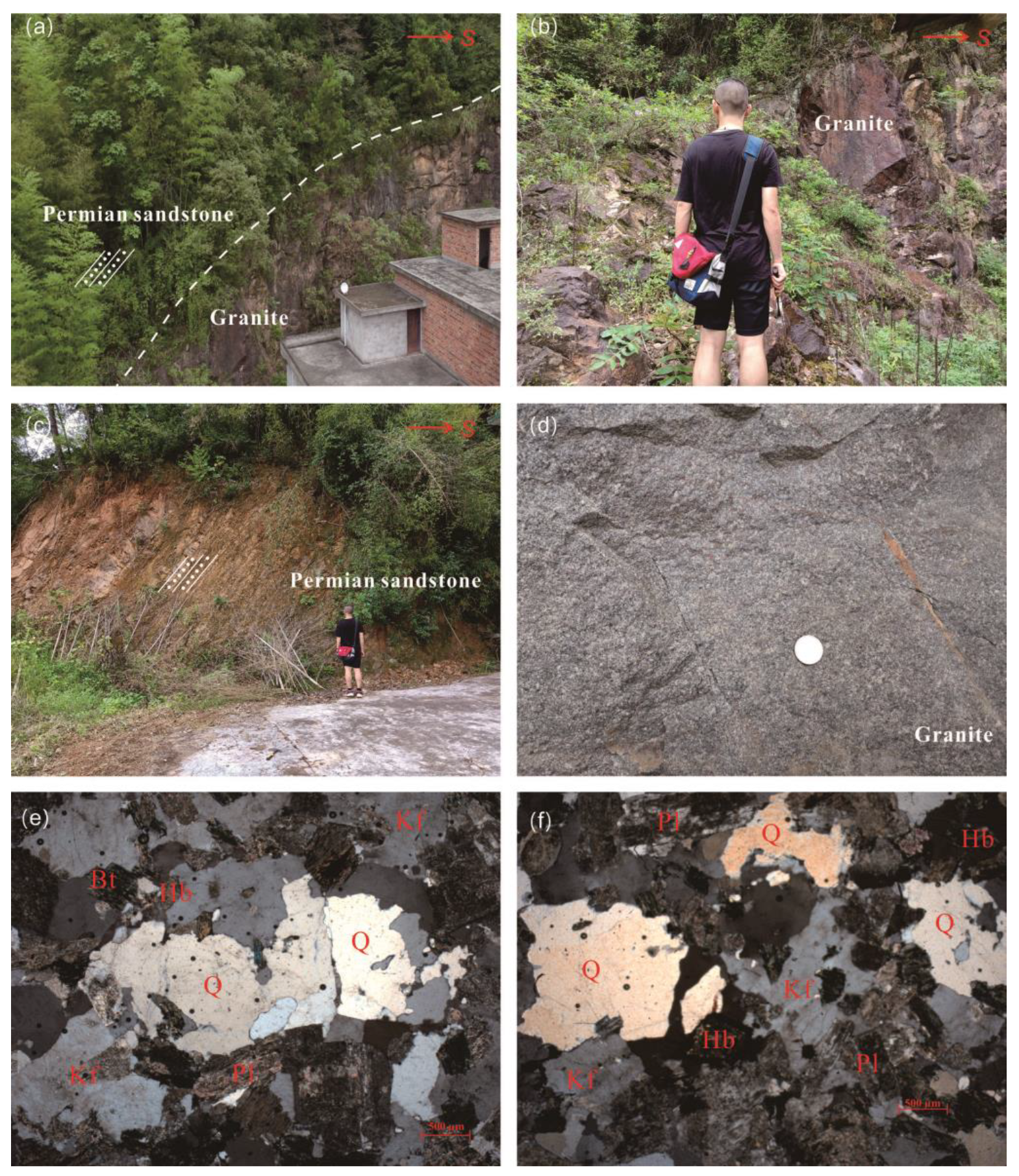
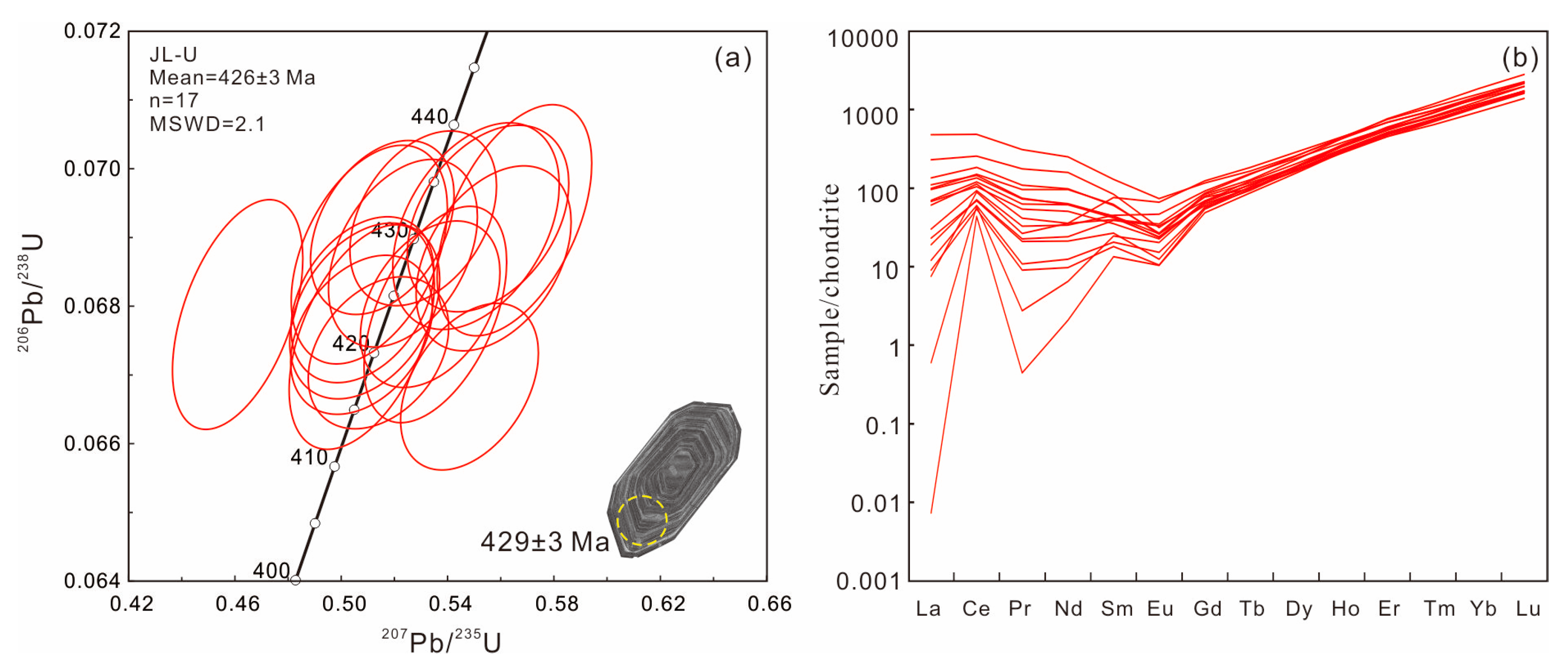
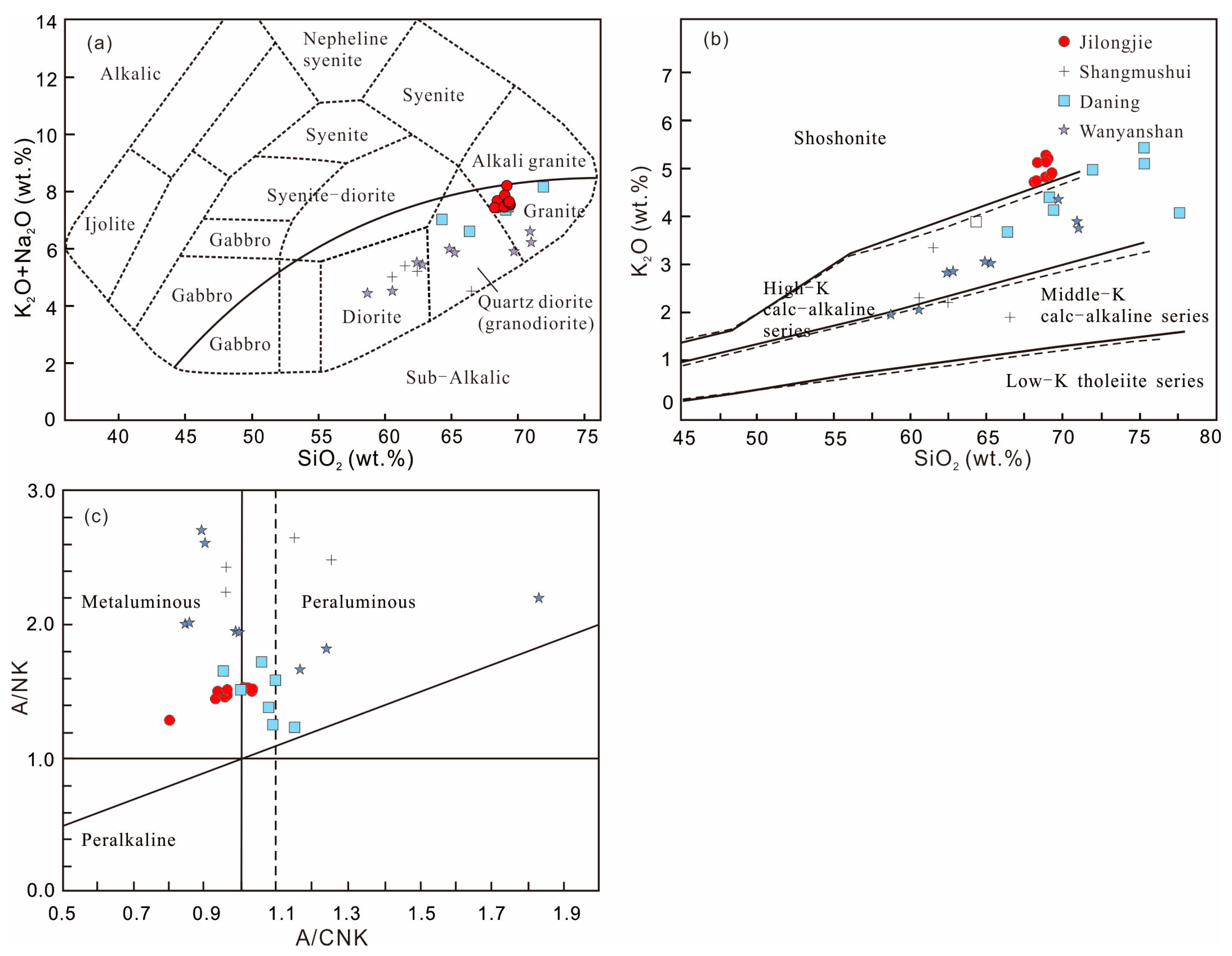
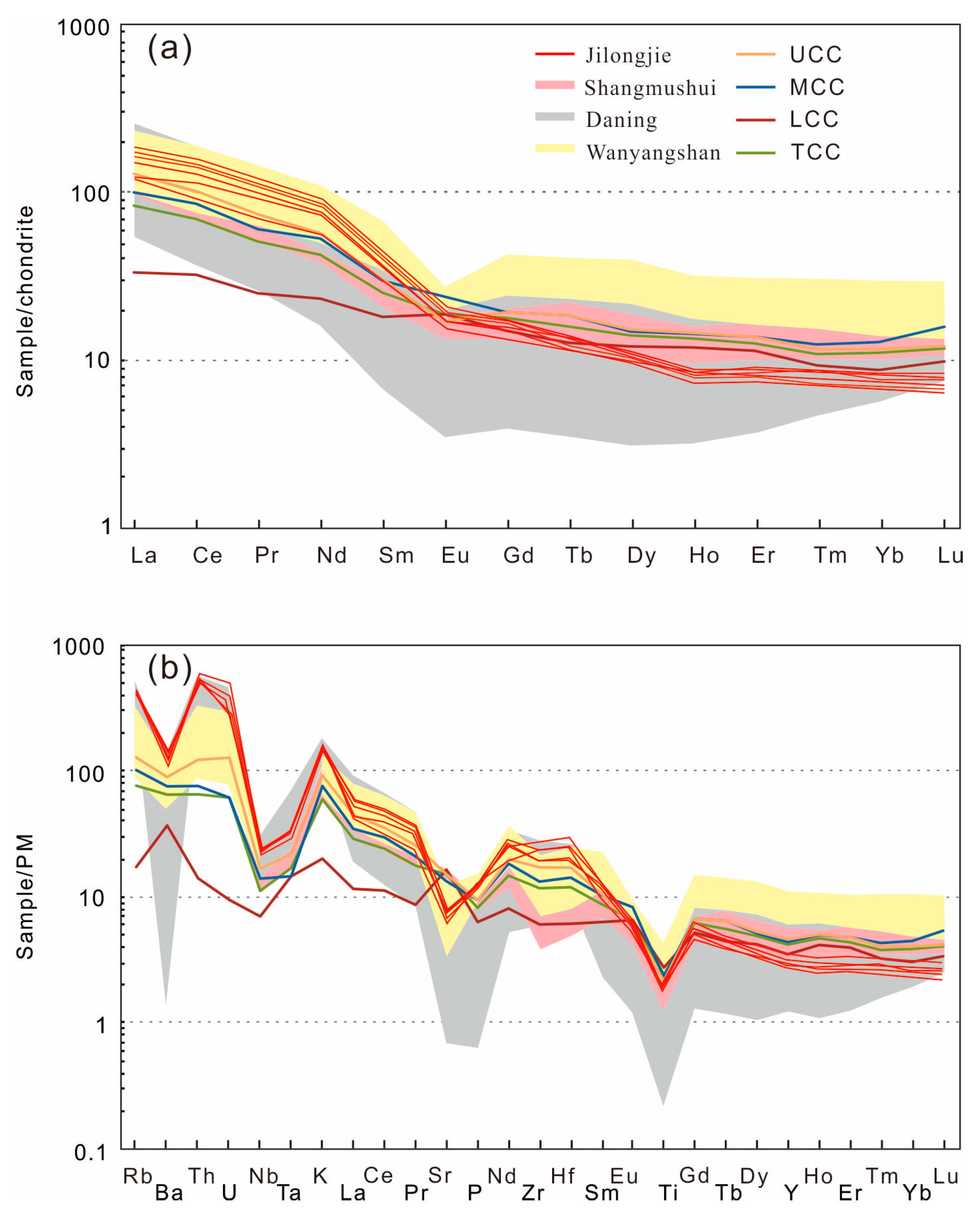
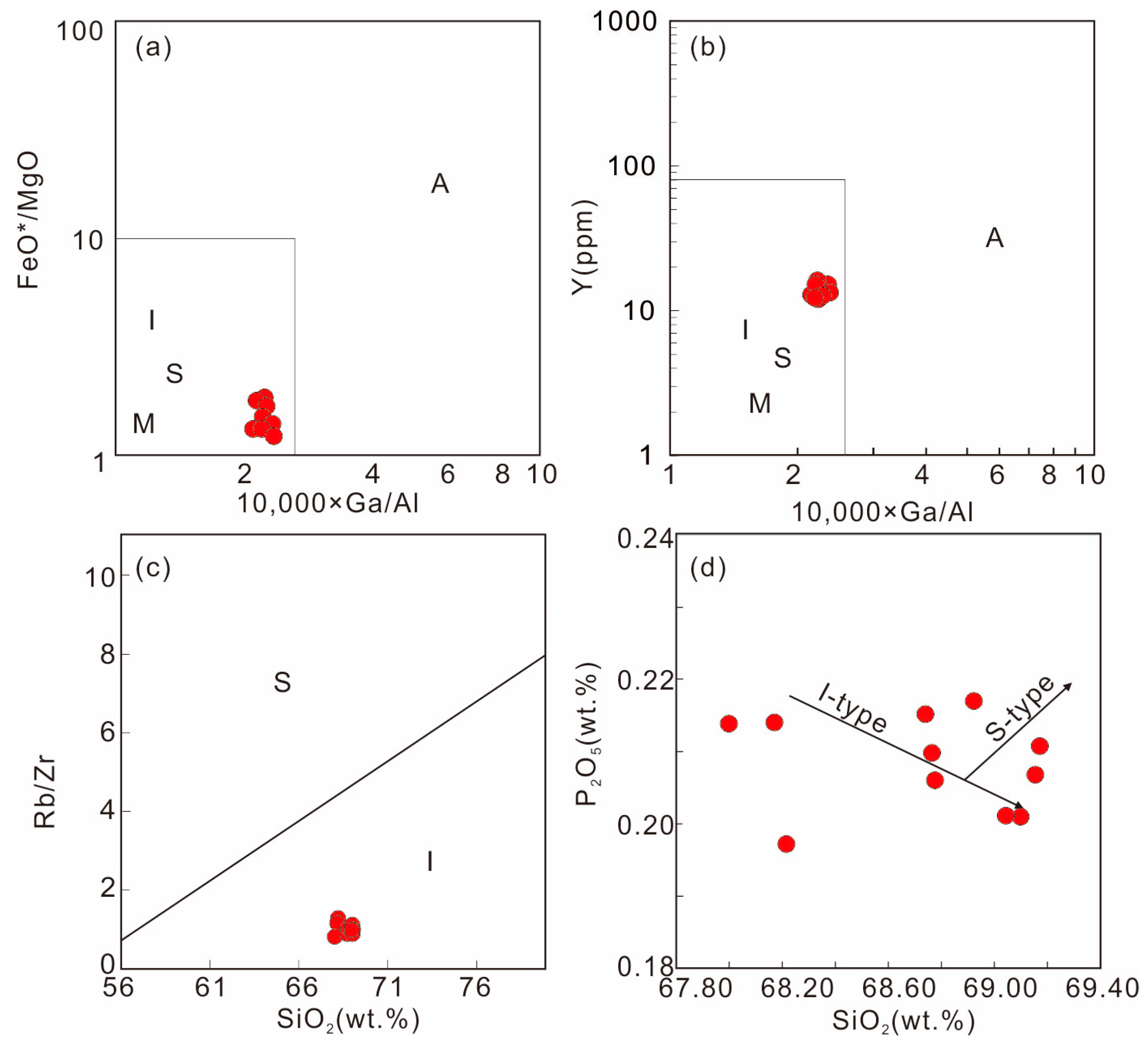
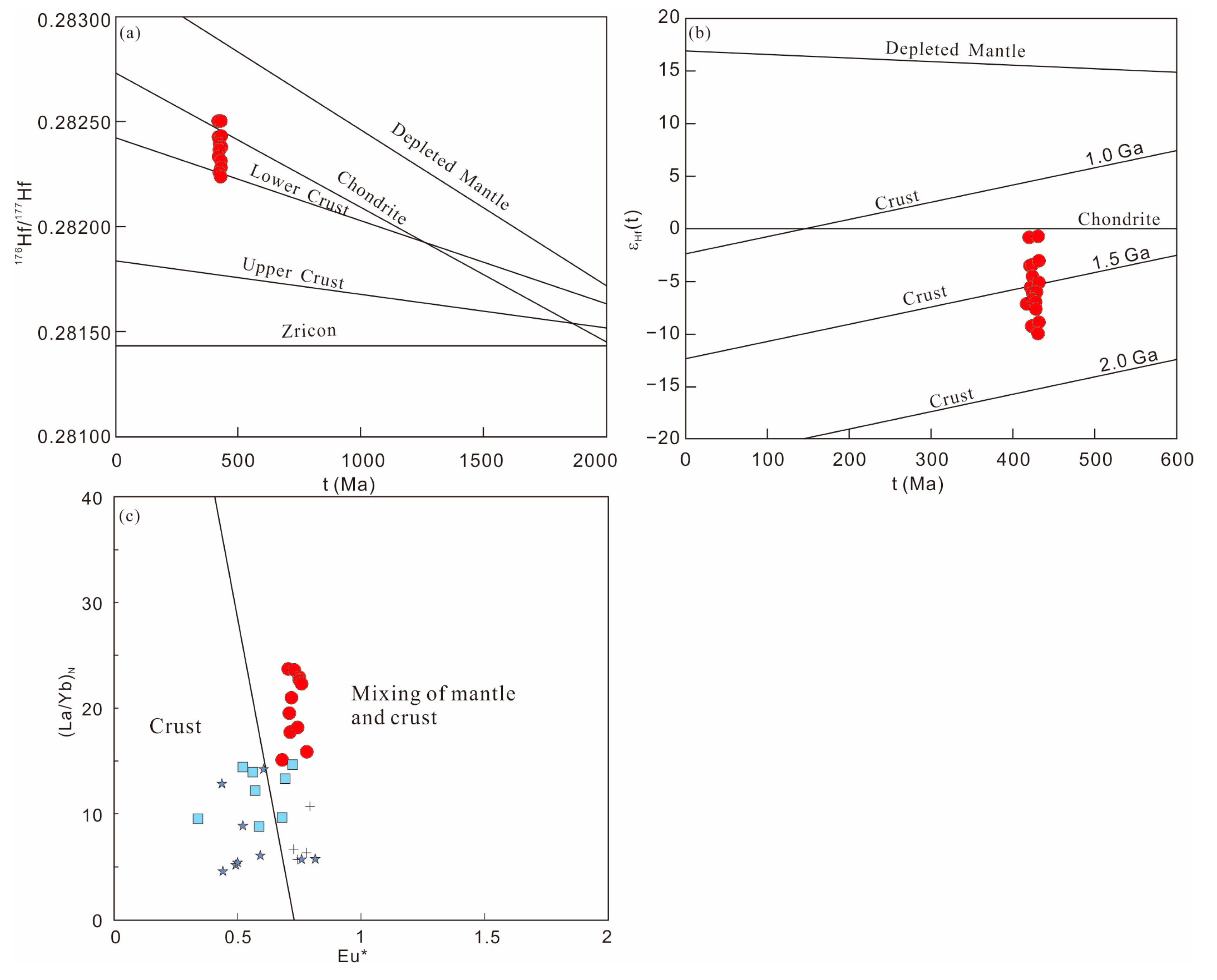
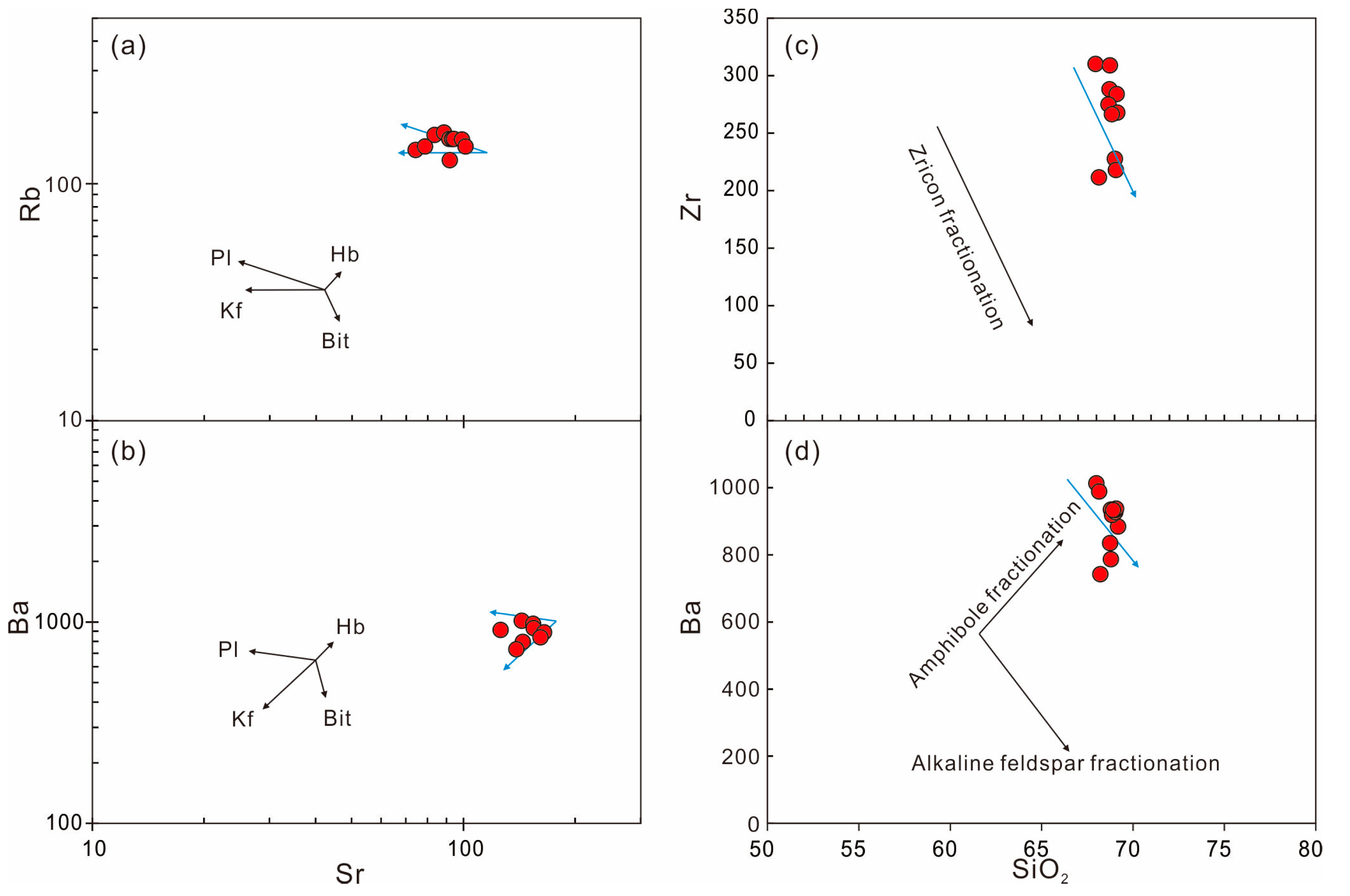
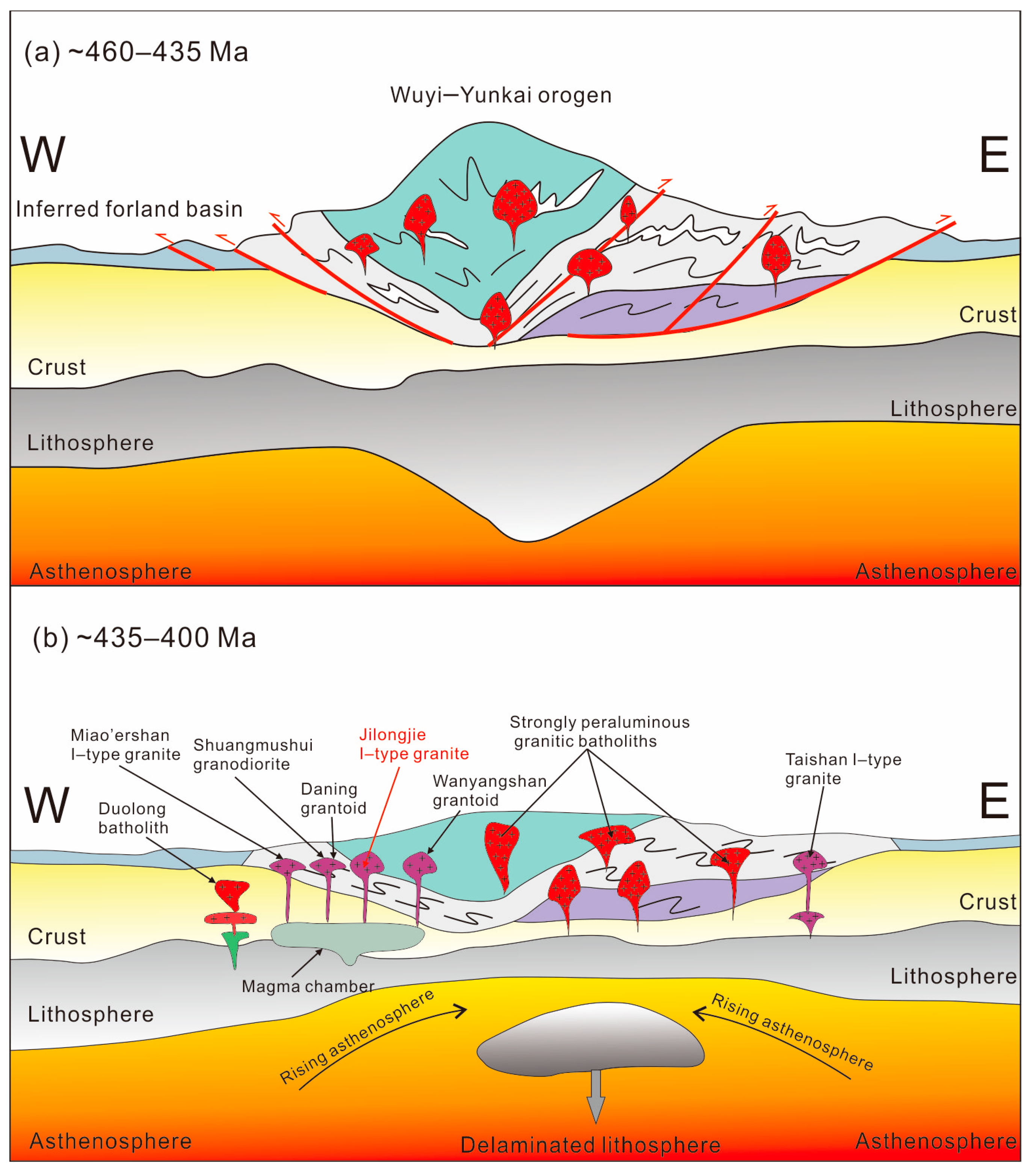
| Samples and Anal. NO. | Th (ppm) | U (ppm) | Th/U Ratio | Isotopic Ratios (±1σ) | Ages (±1σ Ma) | Concordance | ||||||||||
|---|---|---|---|---|---|---|---|---|---|---|---|---|---|---|---|---|
| 207Pb/206Pb | 207Pb/235U | 206Pb/238U | 207Pb/206Pb | 207Pb/235U | 206Pb/238U | |||||||||||
| 1. JL-U-01 | 838 | 1047 | 0.80 | 0.0599 | 0.0013 | 0.5609 | 0.0110 | 0.0679 | 0.0006 | 611 | 51 | 452 | 7 | 423 | 4 | 93% |
| 2. JL-U-02 | 535 | 745 | 0.72 | 0.0602 | 0.0013 | 0.5762 | 0.0128 | 0.0692 | 0.0006 | 613 | 46 | 462 | 8 | 431 | 4 | 93% |
| 3. JL-U-03 | 963 | 1035 | 0.93 | 0.0572 | 0.0013 | 0.5332 | 0.0112 | 0.0676 | 0.0007 | 498 | 45 | 434 | 7 | 421 | 4 | 97% |
| 4. JL-U-04 | 1019 | 1029 | 0.99 | 0.0615 | 0.0012 | 0.5906 | 0.0119 | 0.0693 | 0.0007 | 657 | 44 | 471 | 8 | 432 | 4 | 91% |
| 5. JL-U-05 | 628 | 867 | 0.72 | 0.0612 | 0.0013 | 0.5828 | 0.0119 | 0.0687 | 0.0005 | 656 | 38 | 466 | 8 | 428 | 3 | 91% |
| 6. JL-U-06 | 575 | 772 | 0.75 | 0.0593 | 0.0012 | 0.5589 | 0.0107 | 0.0680 | 0.0005 | 589 | 10 | 451 | 7 | 424 | 3 | 93% |
| 7. JL-U-07 | 705 | 908 | 0.78 | 0.0520 | 0.0011 | 0.4865 | 0.0100 | 0.0679 | 0.0007 | 283 | 48 | 403 | 7 | 423 | 4 | 94% |
| 8. JL-U-08 | 824 | 973 | 0.85 | 0.0576 | 0.0012 | 0.5487 | 0.0115 | 0.0688 | 0.0006 | 522 | 44 | 444 | 8 | 429 | 3 | 96% |
| 9. JL-U-09 | 648 | 926 | 0.70 | 0.0566 | 0.0012 | 0.5334 | 0.0110 | 0.0681 | 0.0005 | 476 | 46 | 434 | 7 | 425 | 3 | 97% |
| 10. JL-U-10 | 1465 | 1032 | 1.42 | 0.0565 | 0.0013 | 0.5360 | 0.0120 | 0.0688 | 0.0006 | 478 | 52 | 436 | 8 | 429 | 4 | 98% |
| 11. JL-U-11 | 584 | 1001 | 0.58 | 0.0578 | 0.0012 | 0.5395 | 0.0108 | 0.0673 | 0.0005 | 524 | 44 | 438 | 7 | 420 | 3 | 95% |
| 12. JL-U-12 | 541 | 883 | 0.61 | 0.0570 | 0.0012 | 0.5332 | 0.0109 | 0.0676 | 0.0005 | 494 | 42 | 434 | 7 | 422 | 3 | 97% |
| 13. JL-U-13 | 710 | 951 | 0.75 | 0.0620 | 0.0012 | 0.5737 | 0.0106 | 0.0668 | 0.0005 | 676 | 43 | 460 | 7 | 417 | 3 | 90% |
| 14. JL-U-14 | 666 | 968 | 0.69 | 0.0579 | 0.0012 | 0.5563 | 0.0113 | 0.0693 | 0.0005 | 528 | 46 | 449 | 7 | 432 | 3 | 96% |
| 15. JL-U-15 | 610 | 859 | 0.71 | 0.0567 | 0.0013 | 0.5344 | 0.0115 | 0.0679 | 0.0005 | 480 | 48 | 435 | 8 | 424 | 3 | 97% |
| 16. JL-U-16 | 691 | 939 | 0.74 | 0.0565 | 0.0012 | 0.5409 | 0.0110 | 0.0691 | 0.0005 | 472 | 44 | 439 | 7 | 431 | 3 | 98% |
| 17. JL-U-17 | 1048 | 960 | 1.09 | 0.0605 | 0.0013 | 0.5807 | 0.0124 | 0.0693 | 0.0006 | 620 | 46 | 465 | 8 | 432 | 3 | 92% |
| Samples | La | Ce | Pr | Nd | Sm | Eu | Gd | Tb | Dy | Ho | Er | Tm | Yb | Lu | Hf |
|---|---|---|---|---|---|---|---|---|---|---|---|---|---|---|---|
| JL-U-01 | 14.4 | 69.1 | 3.93 | 16.7 | 6.05 | 2.02 | 17.8 | 5.62 | 64.7 | 25.2 | 123 | 27.6 | 269 | 57.4 | 11,975 |
| JL-U-02 | 4.49 | 43.6 | 2.15 | 11.3 | 5.94 | 1.92 | 14.2 | 4.13 | 44.9 | 16.3 | 74.6 | 16.2 | 159 | 35.1 | 11,808 |
| JL-U-03 | 113 | 296 | 29.2 | 117 | 19.8 | 4.28 | 23.8 | 6.17 | 65.7 | 24.0 | 113 | 24.8 | 251 | 55.4 | 10,905 |
| JL-U-04 | 0.14 | 36.0 | 0.26 | 3.04 | 3.76 | 1.18 | 14.1 | 4.64 | 52.0 | 19.5 | 93.2 | 20.3 | 201 | 43.7 | 12,041 |
| JL-U-05 | 54.2 | 156 | 16.6 | 73.8 | 12.8 | 1.82 | 15.8 | 3.66 | 42.0 | 15.8 | 74.9 | 17.6 | 182 | 41.0 | 12,484 |
| JL-U-06 | 16.0 | 63.7 | 5.14 | 23.6 | 5.41 | 1.31 | 14.0 | 4.11 | 47.6 | 17.5 | 83.7 | 18.8 | 188 | 42.1 | 11,647 |
| JL-U-07 | 5.48 | 42.2 | 1.99 | 9.89 | 4.10 | 0.72 | 11.9 | 3.50 | 43.5 | 17.0 | 84.4 | 18.7 | 192 | 43.8 | 11,190 |
| JL-U-08 | 26.1 | 88.4 | 7.05 | 29.0 | 6.72 | 1.51 | 12.3 | 3.77 | 42.7 | 16.8 | 81.0 | 18.6 | 189 | 41.9 | 11,752 |
| JL-U-09 | 7.3 | 26.6 | 0.042 | 0.97 | 2.05 | 0.60 | 9.93 | 3.25 | 39.5 | 16.1 | 78.9 | 18.3 | 189 | 43.4 | 12,680 |
| JL-U-10 | 1.79 | 54.3 | 2.52 | 16.6 | 11.5 | 3.81 | 25.3 | 6.83 | 73.2 | 25.4 | 113 | 24.5 | 233 | 50.1 | 10,947 |
| JL-U-11 | 31.8 | 113 | 10.3 | 45.7 | 9.2 | 1.55 | 17.2 | 4.77 | 58.1 | 24.2 | 126 | 29.8 | 313 | 71.2 | 12,653 |
| JL-U-12 | 2.14 | 32.9 | 0.85 | 4.54 | 2.77 | 0.61 | 11.1 | 3.64 | 47.0 | 19.4 | 98 | 23.2 | 243 | 56.0 | 12,367 |
| JL-U-13 | 22.7 | 82.2 | 6.88 | 29.6 | 6.70 | 1.36 | 13.0 | 3.75 | 41.5 | 16.1 | 78.7 | 18.2 | 186 | 41.8 | 12,362 |
| JL-U-14 | 2.84 | 36.6 | 1.03 | 5.79 | 3.13 | 0.89 | 11.4 | 3.91 | 48.0 | 20.1 | 98.8 | 22.9 | 240 | 54.4 | 12,462 |
| JL-U-15 | 16.6 | 73.5 | 5.98 | 28.6 | 6.43 | 1.39 | 13.6 | 4.14 | 47.3 | 18.9 | 90.3 | 21.1 | 216 | 49.8 | 11,889 |
| JL-U-16 | 23.3 | 91.3 | 9.15 | 44.7 | 9.49 | 1.51 | 16.3 | 4.37 | 46.4 | 17.5 | 84.3 | 19.1 | 191 | 43.1 | 12,040 |
| JL-U-17 | 7.15 | 56.7 | 3.10 | 15.8 | 6.88 | 2.70 | 19.0 | 5.70 | 61.0 | 21.3 | 96.2 | 20.8 | 203 | 43.5 | 10,285 |
| Sample | JL-1H | JL-2H | JL-3H | JL-4H | JL-5H | JL-6H | JL-7H | JL-8H | JL-9H | JL-10H | JL-11H |
|---|---|---|---|---|---|---|---|---|---|---|---|
| Rock type | Granite | ||||||||||
| SiO2 | 65.48 | 64.95 | 64.70 | 66.34 | 64.27 | 65.47 | 65.81 | 65.22 | 65.22 | 65.97 | 65.70 |
| TiO2 | 0.53 | 0.55 | 0.52 | 0.55 | 0.55 | 0.57 | 0.57 | 0.56 | 0.54 | 0.52 | 0.52 |
| Al2O3 | 14.31 | 13.79 | 14.18 | 13.94 | 13.61 | 12.95 | 14.07 | 13.83 | 14.01 | 13.87 | 13.72 |
| Fe2O3T | 3.14 | 3.42 | 3.46 | 3.23 | 3.31 | 3.06 | 3.30 | 2.72 | 3.16 | 2.89 | 2.88 |
| MnO | 0.04 | 0.05 | 0.05 | 0.05 | 0.06 | 0.05 | 0.05 | 0.06 | 0.05 | 0.05 | 0.05 |
| MgO | 1.67 | 2.40 | 1.86 | 2.06 | 2.50 | 1.56 | 2.09 | 1.89 | 2.02 | 2.05 | 2.03 |
| CaO | 2.41 | 2.84 | 2.62 | 2.33 | 3.00 | 3.33 | 2.51 | 2.90 | 2.31 | 2.74 | 2.72 |
| Na2O | 2.50 | 2.65 | 2.51 | 2.60 | 2.64 | 2.93 | 2.61 | 2.67 | 2.63 | 2.72 | 2.72 |
| K2O | 4.94 | 4.44 | 4.77 | 4.62 | 4.38 | 4.87 | 4.54 | 4.79 | 4.62 | 4.56 | 4.55 |
| P2O5 | 0.20 | 0.20 | 0.19 | 0.20 | 0.20 | 0.21 | 0.21 | 0.20 | 0.20 | 0.19 | 0.19 |
| L.O.I | 2.17 | 2.74 | 2.49 | 1.83 | 2.04 | 3.04 | 1.99 | 2.68 | 1.87 | 2.46 | 2.38 |
| Total | 99.38 | 100.01 | 99.34 | 99.73 | 99.57 | 100.03 | 99.73 | 99.52 | 99.63 | 100.01 | 99.46 |
| A/CNK | 1.03 | 0.96 | 1.01 | 1.03 | 0.94 | 0.80 | 1.02 | 0.93 | 1.04 | 0.96 | 0.96 |
| A/NK | 1.51 | 1.51 | 1.53 | 1.50 | 1.50 | 1.28 | 1.53 | 1.44 | 1.50 | 1.47 | 1.46 |
| Mg# | 51.26 | 58.13 | 51.51 | 55.79 | 59.92 | 50.22 | 55.57 | 57.85 | 55.93 | 58.41 | 58.24 |
| Trace element (ppm) | |||||||||||
| Sc | 10.8 | 10.0 | 11.0 | 10.9 | 10.9 | 8.49 | 11.0 | 11.0 | 10.9 | 9.49 | 9.31 |
| V | 67.0 | 69.0 | 67.3 | 69.8 | 72.4 | 56.2 | 70.5 | 70.6 | 69.8 | 64.1 | 63.3 |
| Cr | 150 | 153 | 149 | 160 | 161 | 156 | 150 | 159 | 158 | 143 | 142 |
| Co | 10.8 | 11.4 | 12.8 | 10.5 | 11.9 | 6.87 | 10.4 | 7.82 | 9.89 | 9.23 | 8.93 |
| Ni | 66.3 | 66.1 | 69.9 | 61.2 | 65.3 | 37.9 | 62.1 | 46.2 | 60.5 | 53.1 | 52.0 |
| Ga | 16.5 | 16.9 | 16.7 | 16.6 | 16.7 | 15.4 | 16.4 | 16.1 | 16.7 | 16.1 | 15.6 |
| Rb | 287 | 249 | 266 | 252 | 243 | 271 | 249 | 264 | 255 | 247 | 246 |
| Sr | 144 | 154 | 139 | 155 | 144 | 126 | 161 | 154 | 165 | 155 | 155 |
| Y | 15.4 | 14.0 | 16.3 | 14.0 | 15.3 | 13.6 | 14.2 | 14.5 | 13.2 | 13.0 | 12.8 |
| Zr | 287 | 211 | 211 | 284 | 310 | 265 | 274 | 308 | 267 | 226 | 217 |
| Nb | 17.1 | 16.7 | 15.8 | 16.7 | 17.1 | 16.5 | 16.8 | 16.8 | 16.5 | 15.4 | 15.2 |
| Ba | 787 | 990 | 742 | 942 | 1012 | 918 | 836 | 935 | 885 | 923 | 931 |
| La | 41.8 | 41.9 | 37.9 | 40.2 | 36.6 | 28.6 | 44.1 | 29.5 | 41.1 | 38.8 | 35.8 |
| Ce | 88.9 | 89.3 | 81.8 | 88.0 | 81.9 | 56.8 | 97.6 | 70.3 | 89.4 | 87.6 | 79.1 |
| Pr | 10.0 | 10.4 | 9.53 | 10.4 | 9.73 | 6.61 | 11.4 | 8.72 | 10.4 | 10.1 | 9.30 |
| Nd | 38.5 | 39.7 | 36.4 | 39.2 | 37.2 | 26.4 | 42.9 | 34.6 | 39.6 | 38.3 | 35.7 |
| Sm | 5.78 | 5.97 | 5.93 | 6.02 | 5.87 | 4.39 | 6.55 | 5.80 | 5.97 | 5.79 | 5.28 |
| Eu | 1.05 | 1.07 | 1.11 | 1.09 | 1.13 | 0.90 | 1.19 | 0.99 | 1.11 | 1.06 | 1.00 |
| Gd | 3.54 | 3.64 | 3.83 | 3.59 | 3.72 | 2.80 | 3.50 | 3.39 | 3.43 | 3.42 | 3.13 |
| Tb | 0.51 | 0.49 | 0.53 | 0.49 | 0.50 | 0.43 | 0.51 | 0.50 | 0.48 | 0.45 | 0.44 |
| Dy | 2.91 | 2.76 | 3.05 | 2.74 | 2.97 | 2.57 | 2.83 | 2.83 | 2.57 | 2.58 | 2.44 |
| Ho | 0.51 | 0.48 | 0.54 | 0.48 | 0.51 | 0.45 | 0.48 | 0.50 | 0.46 | 0.45 | 0.41 |
| Er | 1.52 | 1.35 | 1.62 | 1.40 | 1.52 | 1.30 | 1.50 | 1.44 | 1.39 | 1.31 | 1.24 |
| Tm | 0.22 | 0.20 | 0.24 | 0.22 | 0.22 | 0.20 | 0.22 | 0.22 | 0.22 | 0.18 | 0.18 |
| Yb | 1.53 | 1.27 | 1.54 | 1.37 | 1.45 | 1.29 | 1.41 | 1.40 | 1.30 | 1.18 | 1.13 |
| Lu | 0.21 | 0.17 | 0.22 | 0.20 | 0.21 | 0.18 | 0.21 | 0.20 | 0.19 | 0.17 | 0.16 |
| Hf | 8.04 | 6.12 | 6.06 | 8.21 | 8.79 | 7.81 | 8.04 | 9.15 | 7.98 | 6.49 | 6.37 |
| Ta | 1.40 | 1.32 | 1.43 | 1.33 | 1.35 | 1.38 | 1.36 | 1.38 | 1.35 | 1.24 | 1.19 |
| Pb | 34.1 | 35.5 | 35.4 | 37.9 | 33.6 | 39.2 | 39.4 | 40.1 | 38.8 | 36.4 | 37.3 |
| Th | 45.0 | 49.8 | 44.6 | 50.3 | 44.9 | 51.5 | 47.8 | 47.3 | 44.9 | 52.0 | 48.1 |
| U | 6.47 | 5.34 | 7.63 | 6.41 | 5.56 | 10.4 | 6.23 | 7.05 | 8.33 | 6.20 | 5.76 |
| ∑REE | 223.16 | 222.64 | 211.59 | 220.30 | 209.81 | 155.07 | 239.67 | 185.96 | 221.71 | 213.82 | 197.45 |
| (La/Yb)N | 19.58 | 23.72 | 17.69 | 21.04 | 18.16 | 15.87 | 22.40 | 15.12 | 22.62 | 23.58 | 22.82 |
| Eu/Eu* | 0.71 | 0.71 | 0.71 | 0.72 | 0.74 | 0.78 | 0.76 | 0.68 | 0.75 | 0.73 | 0.75 |
| Sample No. | Age/Ma | 176Yb/177Hf | 2σ | 176Lu/177Hf | 2σ | 176Hf/177Hf | 2σ | εHf(0) | εHf(t) | TDM(Ga) | TDMC (Ga) | fLu/Hf |
|---|---|---|---|---|---|---|---|---|---|---|---|---|
| JL-U-01 | 423 | 0.0356 | 0.0010 | 0.001495 | 0.000038 | 0.282353 | 0.000024 | −14.82 | −5.94 | 1.29 | 1.78 | −0.95 |
| JL-U-02 | 431 | 0.0534 | 0.0006 | 0.002153 | 0.000027 | 0.282502 | 0.000014 | −9.56 | −0.69 | 1.09 | 1.46 | −0.94 |
| JL-U-03 | 421 | 0.0353 | 0.0003 | 0.001411 | 0.000021 | 0.282422 | 0.000019 | −12.37 | −3.50 | 1.19 | 1.63 | −0.96 |
| JL-U-04 | 432 | 0.0562 | 0.0006 | 0.002283 | 0.000024 | 0.282378 | 0.000013 | −13.93 | −5.08 | 1.28 | 1.74 | −0.93 |
| JL-U-05 | 428 | 0.0314 | 0.0005 | 0.001303 | 0.000021 | 0.282305 | 0.000014 | −16.52 | −7.48 | 1.35 | 1.89 | −0.96 |
| JL-U-06 | 424 | 0.0417 | 0.0006 | 0.001740 | 0.000021 | 0.282424 | 0.000015 | −12.30 | −3.46 | 1.19 | 1.63 | −0.95 |
| JL-U-07 | 423 | 0.0374 | 0.0006 | 0.001508 | 0.000026 | 0.282260 | 0.000015 | −18.10 | −9.22 | 1.42 | 1.99 | −0.95 |
| JL-U-08 | 429 | 0.0482 | 0.0007 | 0.001979 | 0.000024 | 0.282324 | 0.000018 | −15.84 | −6.96 | 1.34 | 1.85 | −0.94 |
| JL-U-09 | 425 | 0.0332 | 0.0006 | 0.001387 | 0.000025 | 0.282336 | 0.000022 | −15.43 | −6.48 | 1.31 | 1.82 | −0.96 |
| JL-U-10 | 429 | 0.0337 | 0.0022 | 0.001377 | 0.000088 | 0.282347 | 0.000015 | −15.03 | −5.98 | 1.29 | 1.79 | −0.96 |
| JL-U-11 | 420 | 0.0423 | 0.0007 | 0.001754 | 0.000023 | 0.282501 | 0.000017 | −9.57 | −0.81 | 1.08 | 1.46 | −0.95 |
| JL-U-12 | 422 | 0.0394 | 0.0015 | 0.001636 | 0.000059 | 0.282366 | 0.000017 | −14.37 | −5.55 | 1.27 | 1.76 | −0.95 |
| JL-U-13 | 417 | 0.0362 | 0.0010 | 0.001481 | 0.000038 | 0.282323 | 0.000014 | −15.88 | −7.12 | 1.33 | 1.85 | −0.96 |
| JL-U-14 | 432 | 0.0373 | 0.0011 | 0.001540 | 0.000041 | 0.282430 | 0.000015 | −12.09 | −3.03 | 1.18 | 1.61 | −0.95 |
| JL-U-15 | 424 | 0.0530 | 0.0021 | 0.002127 | 0.000089 | 0.282398 | 0.000016 | −13.23 | −4.50 | 1.24 | 1.69 | −0.94 |
| JL-U-16 | 431 | 0.0462 | 0.0006 | 0.001863 | 0.000022 | 0.282238 | 0.000034 | −18.88 | −9.94 | 1.46 | 2.04 | −0.94 |
| JL-U-17 | 432 | 0.0304 | 0.0007 | 0.001295 | 0.000029 | 0.282264 | 0.000016 | −17.98 | −8.85 | 1.41 | 1.98 | −0.96 |
Disclaimer/Publisher’s Note: The statements, opinions and data contained in all publications are solely those of the individual author(s) and contributor(s) and not of MDPI and/or the editor(s). MDPI and/or the editor(s) disclaim responsibility for any injury to people or property resulting from any ideas, methods, instructions or products referred to in the content. |
© 2023 by the authors. Licensee MDPI, Basel, Switzerland. This article is an open access article distributed under the terms and conditions of the Creative Commons Attribution (CC BY) license (https://creativecommons.org/licenses/by/4.0/).
Share and Cite
He, H.; Wang, T.; Sui, Q.; Duan, X.; Ren, X.; Hou, D.; Xie, Y.; Liu, S.; Feng, P.; Zhang, H.; et al. Geochronology and Petrogenesis of the Early Paleozoic Jilongjie Granites in the Central South China Block: Implication for Post-Kinematic Lithospheric Delamination. Minerals 2023, 13, 734. https://doi.org/10.3390/min13060734
He H, Wang T, Sui Q, Duan X, Ren X, Hou D, Xie Y, Liu S, Feng P, Zhang H, et al. Geochronology and Petrogenesis of the Early Paleozoic Jilongjie Granites in the Central South China Block: Implication for Post-Kinematic Lithospheric Delamination. Minerals. 2023; 13(6):734. https://doi.org/10.3390/min13060734
Chicago/Turabian StyleHe, Haiyang, Tingting Wang, Qinglin Sui, Xianzhe Duan, Xuan Ren, Danping Hou, Yanshi Xie, Shan Liu, Peng Feng, Huanbao Zhang, and et al. 2023. "Geochronology and Petrogenesis of the Early Paleozoic Jilongjie Granites in the Central South China Block: Implication for Post-Kinematic Lithospheric Delamination" Minerals 13, no. 6: 734. https://doi.org/10.3390/min13060734
APA StyleHe, H., Wang, T., Sui, Q., Duan, X., Ren, X., Hou, D., Xie, Y., Liu, S., Feng, P., Zhang, H., & Chen, L. (2023). Geochronology and Petrogenesis of the Early Paleozoic Jilongjie Granites in the Central South China Block: Implication for Post-Kinematic Lithospheric Delamination. Minerals, 13(6), 734. https://doi.org/10.3390/min13060734








